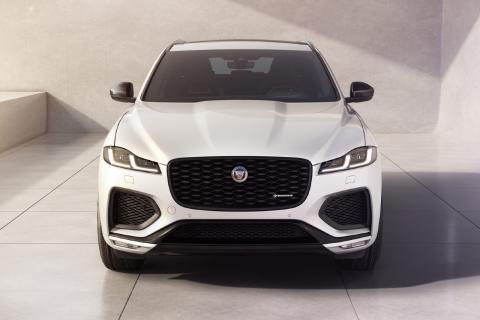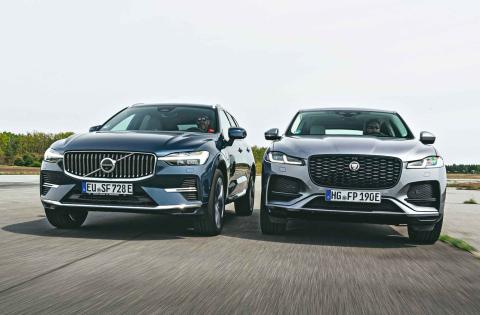
What are the Volvo XC60 and Jaguar F-Pace capable of as plug-in hybrids? That is just what we are going to answer by facing them in this comparison
Does it really always have to be Audi, BMW or Mercedes when it comes to premium SUVs? Here we have two alternatives: the Jaguar F-Pace P400e AWD and the Volvo XC60 Recharge T6 AWD.
Design
Both have a careful, elegant and independent design. The Volvo has the advantage of more space, offering a few more inches of freedom of movement than the Jaguar pretty much everywhere with no crowding anywhere on board.
The F-Pace’s front seats are softly padded and don’t offer much lateral support, the second row is also very comfortable. The test Volvo has the optional sports seats in the front and we highly recommend them: firm and comfortable, slip-resistant and well-contoured. However, the second row is not as comfortable as its rival, the bench is too short.
In the trunk of the Swede fit from 468 to 1,395 liters, the Jaguar has from 485 to 1,299. But the F-Pace can only carry a maximum of 415 kilograms, not enough in this league. The XC60 reaches 497 kilos.
Volvo and Jaguar, at the level of German competition
Both cars are cleanly finished, with high-quality materials and attractive details, and are therefore fully on a par with the German competition. The Jaguar is the most refined and noble, the Volvo is fresh, clear… and very Scandinavian. matter of taste
Both rely on touch screen monitors to control functions. The F-Pace’s 11.4-inch screen is slightly curved, very practical and attractive in appearance. But the menus are too nested, and voice control only responds to predefined commands, that finding points of interest is difficult.
Volvo now runs Google Android and has simplified the menus on the nine-inch monitor. Everything works fine, special praise goes to the Google Maps navigation system; however, it must always be ‘online’, which is not always the case, and the range of functions is severely restricted. Voice control via “Ok Google” reacts faster and more flexibly than in the Jaguar.
Jaguar and Volvo engines
The F-Pace’s hybrid system includes a longitudinally installed 2.0-liter four-cylinder gasoline engine with 300 PS, an electric motor with 143 PS, a 13.8 kWh battery and ZF’s eight-speed automatic transmission; system performance is 404 hp.
The Jaguar can be charged with 7 kW alternating current and even with 32 kW direct current; this is rare with plug-in hybrids and is an advantage over the Volvo, where a maximum of 3.7 kW is possible.
In the XC60 T6, the hybrid system includes a 2.0-litre transversely-mounted and supercharged four-cylinder petrol engine with 253PS, a 145PS electric motor, a 14.9kWh battery and an Aisin eight-speed automatic transmission. . The power of the system is 350 CV.
Both cars are surprisingly quick, with times of just over five seconds for the 0-to-60 sprint that speak for themselves, remarkable for SUVs of this size and weight. The Volvo is typically limited to a speed of 180 km/h, the Jaguar runs up to 240 with relative ease.
Behavior of the two SUVs
The combination of engine and transmission in the Volvo works more harmoniously than in the Jaguar, it responds faster and more directly. And the XC60 can be driven in one-pedal mode, slowing to a stop, something that’s rare for plug-in hybrids. The petrol engine is well insulated and if you do hear anything it’s a bit like a hiss from a V6 which is very nice.
The Jaguar acts more indecisively overall, especially when the battery is empty. Then the system needs something to resolve itself, and it shakes from time to time. Here, too, the gasoline engine is carefully isolated and what you hear sounds pleasantly raspy.
The F-Pace weighs 112 kilograms more than the already heavy XC60 and feels exactly the same: huge. Jaguar has smoothly tuned it, and it’s best taken easy with its delayed-response steering: that fits perfectly with its comfortable approach.
In direct comparison to the Jaguar, the XC60 feels smaller and more agile, however the smooth, decoupled, slightly bump-sensitive steering offers room for improvement.
The XC60 in the test was equipped with the optional adaptive air suspension. This offers the advantage of height adjustment in off-road mode, but it doesn’t respond particularly sensitively, especially on short undulations like cobblestones. The Volvo does accumulate points with its brakes: 34 meters to stop hot from 100 km/h, compared to 35.4 for the Jaguar.
Purely electrically, we covered 43 kilometers with the F-Pace in the test, with the Volvo it was 64. Even with a flat battery, the Swede was still more economical, reaching a consumption of 8.8 liters, and the Jaguar at the 10.9.
The good news: Unlike many other plug-in hybrids with their mini tanks, both have decent fuel reserves: the XC60 has 71 liters, the F-Pace 69.
Factors to decide the purchase
Place 1: Volvo XC60 Recharge T6. It has a lot of space and the hybrid system is more harmonious. Very good brakes. High price.
Place 2: Jaguar F-Pace P400e. A decidedly refined and elegant interior and great driving comfort speak in favor of the Jaguar. It is even more expensive than the Volvo.



















